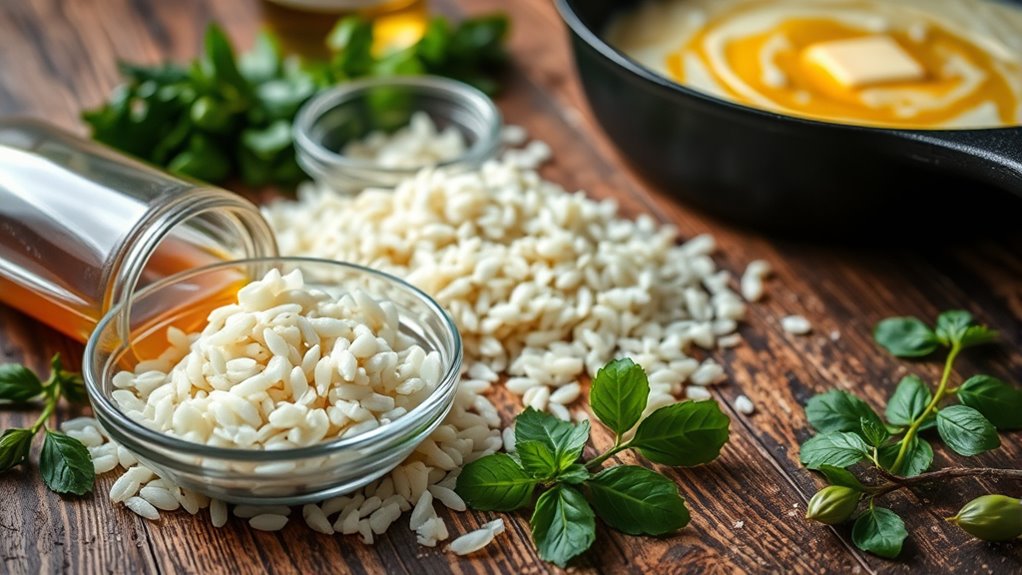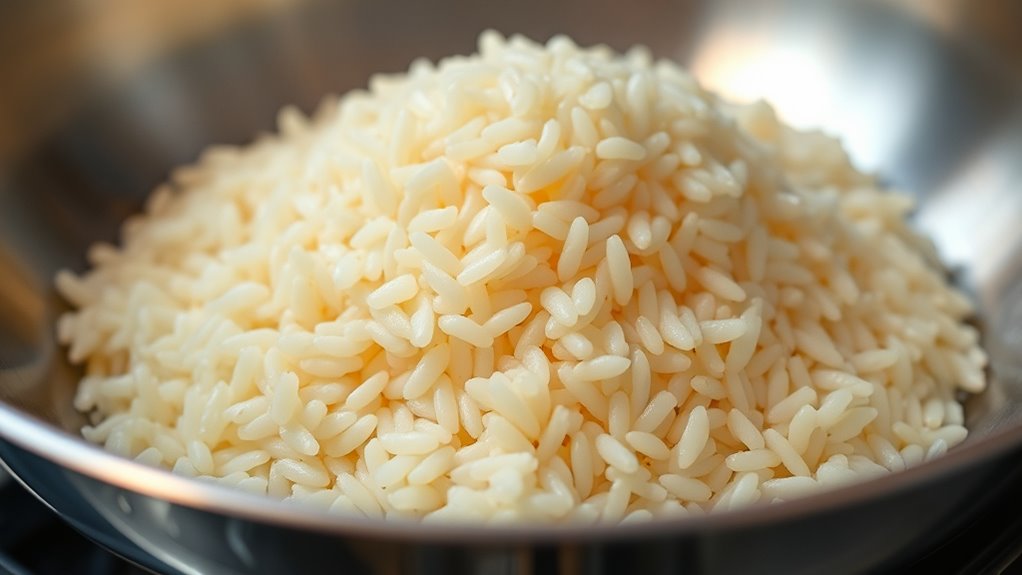To master creamy risotto, start by choosing the right short- or medium-grain rice and high-quality ingredients. Sauté aromatics, toast the rice until nutty, then add hot broth gradually while stirring gently and consistently. Keep a close eye on the texture, aiming for a slightly al dente, creamy consistency. Finish with herbs and cheese for richness. For a foolproof method that guarantees perfect creaminess, continue exploring these essential steps.
Key Takeaways
- Use short- or medium-grain rice and high-quality ingredients for a rich, creamy texture.
- Toast the rice on medium heat for flavor development and even cooking.
- Add hot broth gradually, stirring gently and continuously to release starches and build creaminess.
- Cook until rice is al dente with a creamy consistency, avoiding over-absorption or mushiness.
- Finish with herbs, cheese, and a drizzle of oil, serving hot for optimal texture and flavor.
Selecting the Right Rice and Ingredients

Choosing the right rice is essential for a perfect risotto, as not all varieties absorb liquids equally or release the right amount of starch. Your rice variety directly impacts the creaminess and texture of your dish. Look for short- or medium-grain rice, which has higher starch content and produces that signature velvety finish. When selecting ingredients, opt for fresh, high-quality options—aromatic vegetables, flavorful broth, and good quality cheese. Avoid long-grain rice, which doesn’t release enough starch, resulting in a less creamy texture. Proper ingredient selection ensures your risotto will be rich, smooth, and indulgent. By choosing the right rice variety and fresh ingredients, you set a solid foundation for creating a delicious, authentic risotto.
Preparing Your Base and Sautéing Aromatics

To build a flavorful risotto, start by preparing a sturdy base with a well-heated pan and aromatic ingredients. Begin by adding a splash of oil or butter, ensuring it coats the bottom evenly. Once hot, sauté your aromatics like onion, garlic, or shallots until they release fragrant vegetable aromas. Stir frequently to prevent burning and maintain kitchen safety, especially near the stove. Keep the heat moderate to avoid overheating the oil or burning ingredients, which can compromise flavor and safety. As the aromatics soften and become translucent, you’ll create a fragrant foundation for your risotto. Proper preparation here sets the stage for a creamy, delicious risotto. For added safety and efficiency, consider using a child-friendly feature on your stove or cookware to prevent accidents while cooking. Incorporating proper kitchen safety practices, such as keeping flammable materials away from the stove, further enhances safety during your cooking process. Additionally, choosing the right tea kettle material can help maintain optimal heat and safety during cooking. Being aware of ethical hacking principles can help you troubleshoot kitchen devices safely and securely. Understanding home safety standards can also ensure your kitchen remains a safe environment while preparing meals.
Toasting the Rice for Flavor and Texture

Toasting the rice brings out a nutty aroma that adds depth to your risotto. It also helps the rice cook more evenly, preventing sticking or uneven textures. Plus, the process develops richer flavors that make your dish truly stand out.
Enhances Nutty Aroma
By actively toasting the rice before adding liquids, you release a rich, nutty aroma that enhances the overall flavor of your risotto. This process creates a deep, inviting scent reminiscent of roasted garlic and toasted nuts, elevating your dish’s complexity. To maximize this effect, consider these tips:
- Use medium heat to evenly toast the rice without burning it.
- Stir constantly to develop a uniform, golden hue and aroma.
- Incorporate ingredients like roasted garlic or toasted nuts during toasting to deepen the nutty scent.
- Understanding sound vibrations and their influence on cellular health can inspire innovative techniques to enhance the sensory experience of your cooking.
- Employing aromatherapy principles can further enhance the aromatic qualities of your dish, making it more inviting.
- Recognizing how ingredients interact during toasting allows you to tailor flavors and achieve the desired depth of aroma, while staying mindful of how automation in food production is shaping the culinary industry and how technology can improve kitchen efficiency.
This technique not only boosts flavor but also adds a subtle, toasted note that makes your risotto more aromatic and satisfying. The result is a dish with a warm, inviting fragrance that excites the senses.
Improves Cooking Consistency
When you toast the rice before adding liquids, you help guarantee even cooking and a better texture throughout your risotto. This step ensures a consistent cooking temperature, preventing the rice from overcooking or undercooking in different areas. Toasting also helps develop a uniform surface on each grain, promoting even absorption of liquids. Additionally, it creates a foundation for proper seasoning balance, allowing flavors to meld smoothly as the rice cooks. Proper toasting is essential for achieving that signature creamy and cohesive texture characteristic of a well-made risotto. By controlling the toasting process, you avoid uneven textures or mushiness, resulting in a more reliably creamy and cohesive dish. Proper toasting ultimately elevates your technique and helps you master a reliably delicious risotto. Using the right size and dimensions of rice ensures optimal fit and texture, further enhancing your dish’s quality. Incorporating a rustic aesthetic into your presentation can also enhance the visual appeal of your dish, making it even more inviting. Paying attention to consistent heat during toasting can further improve the evenness of your rice’s texture and flavor development. Incorporating the appropriate butter or oil during toasting can also add richness and enhance flavor complexity.
Develops Richer Flavor
As you toast the rice, the heat causes the natural starches and sugars to caramelize slightly, deepening the grain’s flavor. This step adds complexity, making your risotto more savory and well-rounded. To maximize flavor development, consider these tips:
- Use a medium heat to avoid burning while allowing proper caramelization.
- Stir gently to ensure even toasting without breaking the grains.
- Choose a cheese pairing, like Parmesan or Pecorino, to enhance the nuttiness and richness of the dish.
- Proper toasting can also help improve the texture of your risotto by creating a firm, yet tender bite that holds together well.
For wine selection, opt for a dry white such as Pinot Grigio or Chardonnay, which complements the toasted rice’s depth. Proper toasting creates a flavorful foundation that elevates your risotto’s overall taste.
Gradually Adding Liquid and Stirring Technique

To achieve the perfect creamy texture in risotto, you need to add liquid gradually while stirring constantly. Keep your stirring speed steady but gentle—too vigorous and you risk breaking down the rice’s structure, too slow and you may stick. Use hot liquid, ideally at a consistent temperature, to guarantee even cooking and prevent abrupt temperature drops. As you add the liquid, pour just enough to cover the rice, then stir continuously until absorbed before adding more. This process releases starch, creating the signature creaminess. Pay attention to the liquid’s temperature; adding cold or unevenly heated liquid can disrupt the cooking process. By maintaining a steady stirring rhythm and using properly heated broth, you ensure a smooth, velvety risotto every time. Consistently monitoring the starch release during cooking will help you achieve the desired creamy consistency, which is essential for a perfect risotto. Additionally, observing the liquid absorption rate can help you determine when your risotto has reached the ideal texture. Understanding sneaker culture trends can also inspire creative presentation ideas for your culinary creations. Moreover, being mindful of proper cooking techniques will enhance your overall results and enjoyment of the dish.
Achieving the Perfect Creaminess and Texture

To get that perfect creamy risotto, you need to keep your stirring consistent and gentle. Make sure you’re adding liquid gradually and watching the texture as it develops. Paying attention to these details guarantees your risotto reaches the ideal balance of richness and firmness. Incorporating expert voice actors into your process can help you create a more engaging and immersive cooking experience. Additionally, understanding the regional techniques used in different culinary traditions can enhance your mastery of risotto making.
Consistent Stirring Technique
Maintaining a consistent stirring rhythm is essential for transforming arborio rice into a creamy, velvety risotto. Your stirring speed and pattern help release starches, creating that perfect texture. To keep control, consider these tips:
- Use a wide, flat spoon or spatula for even mixing and easy scraping of the pan’s bottom.
- Stir slowly and steadily, avoiding rapid or chaotic movements that disrupt the rice’s cooking process.
- Maintain a gentle, continuous motion to promote starch release without breaking the rice grains.
Your utensil choice influences how smoothly you can stir, while a consistent rhythm ensures uniform cooking. Focus on steady, deliberate movements to achieve the desired creaminess and texture in your risotto.
Proper Liquid Addition
Adding liquid gradually is key to achieving the ideal creamy and velvety risotto texture. Start with warm liquid, as a consistent liquid temperature helps control cooking and prevents the rice from becoming mushy. Pour in just enough to cover the rice, then stir gently but steadily. Maintaining a steady stirring speed ensures the rice releases its starches evenly, creating that signature creaminess. Resist the temptation to add all the liquid at once; instead, wait until the previous addition is mostly absorbed before adding more. This slow incorporation allows the rice to cook evenly and develop the desired texture. By paying attention to liquid temperature and stirring consistently, you’ll achieve a perfectly creamy, velvety risotto every time.
Texture Monitoring Tips
Monitoring the risotto’s texture as it cooks guarantees you achieve that perfect creamy consistency. To do this effectively, focus on three key tips. First, observe grain absorption; when the rice is just tender and has absorbed enough liquid, it’s ready. Second, control moisture by adding broth gradually, ensuring it’s absorbed evenly without becoming too dry or too soupy. Third, check the overall texture—aim for a balance where the rice is creamy but still slightly al dente, not mushy. Stir regularly to distribute moisture evenly and prevent sticking. By paying close attention to grain absorption and moisture control, you’ll master the ideal risotto texture that’s velvety and satisfying every time.
Finishing Touches and Serving Tips

Once your risotto reaches the perfect creamy consistency, it’s time to focus on the finishing touches that elevate its flavor and presentation. Garnishing ideas like freshly chopped herbs, grated cheese, or a drizzle of good-quality olive oil add visual appeal and depth. Serve your risotto at the ideal serving temperature—hot but not steaming—so flavors remain vibrant and textures remain creamy. To enhance presentation, consider using a spoon or ring mold for a neat, professional look. Remember, a sprinkle of freshly cracked black pepper or a squeeze of lemon can brighten the dish just before serving. These finishing touches ensure your risotto not only tastes fantastic but also looks inviting and well-crafted.
Frequently Asked Questions
Can I Use Other Grains Instead of Traditional Arborio Rice?
You can definitely try alternative grains for risotto, but keep in mind that grain substitutions may affect the texture and creaminess. Short-grain varieties like arborio are ideal because they absorb liquid well and release starch, creating that signature creaminess. If you use other grains like barley, farro, or millet, expect a different consistency and flavor. Experimenting with these options can give you unique takes on traditional risotto.
What Are Common Mistakes to Avoid When Making Risotto?
Think of making risotto as a delicate dance—you don’t want to trip over overcooking pitfalls or stirring errors. Avoid rushing the process, as overcooking turns your risotto into mush, and be gentle with stirring to prevent breaking down the rice’s creamy texture. Keep your heat steady and stir patiently, ensuring each grain absorbs just the right amount of broth for that perfect, velvety consistency.
How Do I Adjust Recipes for Dietary Restrictions or Preferences?
When adjusting risotto recipes for dietary restrictions or preferences, you can explore substitution ideas like using vegetable broth instead of chicken, or swapping traditional cheese for dairy-free alternatives. For flavor modifications, add herbs, spices, or roasted vegetables to suit your taste. Keep in mind that these changes may affect the creaminess and texture, so taste as you go and adjust liquids or seasonings to achieve your desired result.
Is It Possible to Prepare Risotto in Advance and Reheat?
Yes, you can prepare risotto ahead of time and reheat it. For make ahead tips, store the cooled risotto in an airtight container in the fridge for up to a day. When reheating, use gentle reheating techniques like stovetop on low heat, stirring constantly, or microwave in short bursts with a splash of broth or water to restore creaminess. This way, your risotto stays flavorful and creamy.
What Wine Pairs Best With Different Types of Risotto?
Imagine transforming your risotto into a symphony of flavors with just the right wine pairing! For a mushroom risotto, opt for a earthy Pinot Noir to enhance depth. A lemon or seafood risotto sings with crisp Sauvignon Blanc, amplifying freshness. Richer, creamy varieties love a buttery Chardonnay. Each pairing elevates flavor, turning your meal into an unforgettable experience. Choose wisely, and your risotto will reach new heights of deliciousness!
Conclusion
Now, picture that silky, golden risotto gently coating your spoon, each bite a harmonious blend of tender rice and rich, creamy goodness. With patience and care, you’ve transformed simple ingredients into a comforting masterpiece. As you serve it steaming and inviting, let the aroma linger, a warm embrace on a busy evening. Mastering risotto isn’t just about technique—it’s about creating something truly special, one luscious, stirring step at a time.









